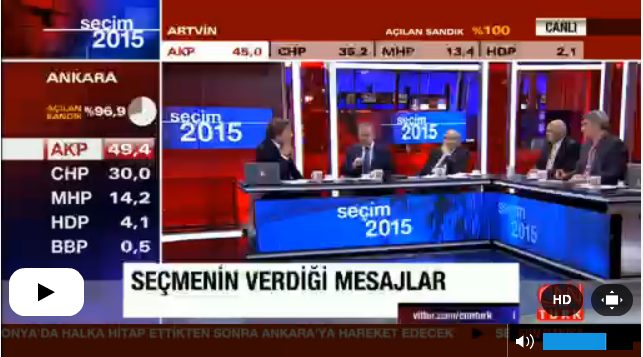All male pontificating panels, copy paste templates and graphics, no sign of swing votes or interviews with candidates, citizen or other stories. It can only mean one thing: Turkish election coverage.

I’m part of the demographic which gets my news primarily from social media (with the FT Weekend, and Monocle magazine notable exceptions). However, with the failure of the Turkey’s ruling AK (justice and development) party to form a coalition government after the June parliamentary elections, a second round was held on November 1st. However when you watch Turkish mainstream media election coverage, ie. TV, there are a few things missing – this by the way has nothing to do with any kind of Turkish media clampdown. It simply appears to be in the lowest common denominator type of coverage that networks seem to go for.
TRT World is the new kid on the block – they’re the new English language channel from the state broadcast although checking in for a few hours, their livestream appears to be down.
I was expecting some livestream coverage on Al Jazeera Turk – now an entirely online operation. The timing is perfect for them to be doing some live coverage (eg. on YouTube or on site) particularly as none of the other main broadcasters seem to be carrying a live feed on the social platforms where you’ll find Turkey’s largely under 30 population. (Nothing live on Facebook for any of these broadcasters either)
So, while dipping in and out of various Turkish media outlets, here’s a quick cheat sheet for the things missing that should be included in any future election to do list.
Women: are there really no female Turkish political commentators available? (Hint, I’m available and have a list of other Turkish female politicos who would be happy to contribute too). Isn’t media supposed to represent the populace (as are elected officials?) particularly when the population is half female and half male?
Include the swing: While we see the aggregate results (the percentage of the vote and number of seats won in parliament), we don’t see the swings. All we hear is speculation on why there are swings. Lets see where the votes and see have been gained and lost then get into the analysis, preferably with an expert from the region. Although not including the swing, Al Jazeera Turk did show the June results alongside.
Interviews. No interviews with candidates, whether victorious or not, no pieces pieces on voting day.
All we see are victory speeches. Why is there any coverage of the consolation speeches? No exit interviews or coverage of the many grass root efforts such as Oy ve Otesi – an organisation mobilising election monitoring and encouraging people to vote
Other election stories of interest. If you skim social media however there are many many stories of people voting in difficult circumstances – for instance elderly, people in ill health taking an ambulance to go vote. There are no pre prepared pieces of election expectations, voter turn out, voting issues etc. Again, social media is faster on this demonstrating that their is no shortage of election related content.
Broadcast live on social platforms With all the fuss made about the blocking of social platforms, why wouldn’t broadcasters use this to their advantage. There were no livestreams on Facebook or YouTube for any of the major broadcasters. This isn’t that surprising as if you have a look at campaigning and media in Turkey, it still is out of touch in the respect that it is still seen as a cute add on rather than as a faster growing media outlet. Not convinced? Check out this essay Damian Radcliffe and I put together for the Reuters Insitute on how Turkey uses social media.



